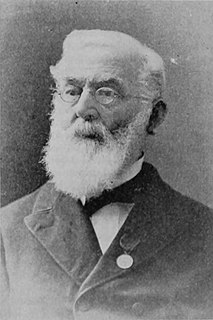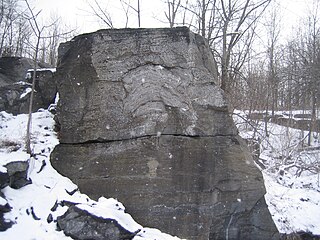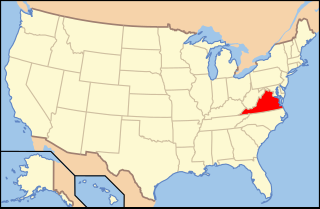
Limestone is a common type of carbonate sedimentary rock. It is composed mostly of the minerals calcite and aragonite, which are different crystal forms of calcium carbonate. Limestone forms when these minerals precipitate out of water containing dissolved calcium. This can take place through both biological and nonbiological processes, though biological processes have likely been more important for the last 540 million years. Limestone often contains fossils, and these provide scientists with information on ancient environments and on the evolution of life.

Increase Allen Lapham was an author, scientist, and naturalist.

James Hall Jr. was an American geologist and paleontologist. He was a noted authority on stratigraphy and had an influential role in the development of paleontology in the United States.

The Wren's Nest is a geological Site of Special Scientific Interest in the Dudley Metropolitan Borough, north west of the town centre of Dudley, in the West Midlands of England. It is one of the most important geological locations in Britain. It is also a Local Nature Reserve, a national nature reserve (NNR) and Scheduled Ancient Monument. The site is home to a number of species of birds and locally rare flora, such as Small Scabious, Milkwort and Quaking Grass. The caverns are also a nationally important hibernation site for seven different species of bat.

The Chazy Reef Formation is a mid-Ordovician limestone deposit in northeastern North America.

The Milwaukee County Historical Society, also known as MCHS, is a local historical society in Milwaukee County, Wisconsin. Founded in 1935, the organization was formed to preserve, collect, recognize, and make available materials related to Milwaukee County history. It is located in downtown Milwaukee in the former Second Ward Savings Bank building.

Soldiers' Home Reef, also known as Rocky Point, National Military Asylum Reef, or Veterans' Hill is a fossilized coral reef rock formation in Milwaukee, Wisconsin. The reef formation was discovered by geologist Increase A. Lapham in the 1830s. It and other fossilized coral reefs that he discovered were the first geological reef formations described in North America, and are among the first described in the world. This reef was declared a National Historic Landmark in 1993.

The Dr. Fisk Holbrook Day House, also known as Sunnyhill Home, is a historic house at 8000 West Milwaukee Avenue in Wauwatosa, Wisconsin. Built in 1874, it was the home of Doctor Fisk Holbrook Day (1826-1903), a prominent local physician and amateur geologist. The stylistically eclectic house was built in part to house Day's large collection of artifacts, and is the Milwaukee suburb's only major 19th-century mansion. It was declared a National Historic Landmark in 1997. It is privately owned and not open to the public.

The Thomas A. Greene Memorial Museum, also known as Greene Geological Museum or Greene Museum, is a mineral and fossil museum in Milwaukee, Wisconsin administered by the Department of Geosciences at the University of Wisconsin–Milwaukee.
Fisk Holbrook Day was a physician and an amateur geologist in Wisconsin who developed an impressive collection of Silurian-age fossils. The collection is now at Harvard University.

Thomas Arnold Greene was an amateur geologist in Wisconsin, USA. He became successful in the retail drug industry in Milwaukee. He collected minerals and Devonian and Silurian fossils. His collection has the distinction of being the sole major nineteenth century Milwaukee area fossil collection to remain intact and in the area. Following his death, his heirs erected a fireproof building in 1913 to house his collection. Known as the Thomas A. Greene Memorial Museum, this building and collection were collectively designated a National Historic Landmark in 1993. The collection was later removed from the building, and is now maintained at Lapham Hall on the University of Wisconsin-Milwaukee campus in a compactor storage system and on display in a small museum area.

Hobbs Quarry, Longhope is a 1-hectare (2.5-acre) geological and biological Site of Special Scientific Interest in Gloucestershire, England, notified in 1966. It is situated midway between Longhope and Dursley Cross in the Forest of Dean. Adjacent woods are Kiln Wood and Coleman's Wood. The site is managed by the Gloucestershire Wildlife Trust.

Paleontology in Illinois refers to paleontological research occurring within or conducted by people from the U.S. state of Illinois. Scientists have found that Illinois was covered by a sea during the Paleozoic Era. Over time this sea was inhabited by animals including brachiopods, clams, corals, crinoids, sea snails, sponges, and trilobites.

Paleontology in Virginia refers to paleontological research occurring within or conducted by people from the U.S. state of Virginia. The geologic column in Virginia spans from the Cambrian to the Quaternary. During the early part of the Paleozoic, Virginia was covered by a warm shallow sea. This sea would come to be inhabited by creatures like brachiopods, bryozoans, corals, and nautiloids. The state was briefly out of the sea during the Ordovician, but by the Silurian it was once again submerged. During this second period of inundation the state was home to brachiopods, trilobites and entire reef systems. During the mid-to-late Carboniferous the state gradually became a swampy environment.

Paleontology in Wisconsin refers to paleontological research occurring within or conducted by people from the U.S. state of Wisconsin. The state has fossils from the Precambrian, much of the Paleozoic, and the later part of the Cenozoic. Most of the Paleozoic rocks are marine in origin. Because of the thick blanket of Pleistocene glacial sediment that covers the rock strata in most of the state, Wisconsin’s fossil record is relatively sparse. In spite of this, certain Wisconsin paleontological occurrences provide exceptional insights concerning the history and diversity of life on Earth.

The history of paleontology in the United States refers to the developments and discoveries regarding fossils found within or by people from the United States of America. Local paleontology began informally with Native Americans, who have been familiar with fossils for thousands of years. They both told myths about them and applied them to practical purposes. African slaves also contributed their knowledge; the first reasonably accurate recorded identification of vertebrate fossils in the new world was made by slaves on a South Carolina plantation who recognized the elephant affinities of mammoth molars uncovered there in 1725. The first major fossil discovery to attract the attention of formally trained scientists were the Ice Age fossils of Kentucky's Big Bone Lick. These fossils were studied by eminent intellectuals like France's George Cuvier and local statesmen and frontiersman like Daniel Boone, Benjamin Franklin, William Henry Harrison, Thomas Jefferson, and George Washington. By the end of the 18th century possible dinosaur fossils had already been found.
The Racine Dolomite is a geologic formation in Illinois and Wisconsin. It preserves fossils dating back to the Silurian period.

The Milwaukee Formation is a fossil-bearing geological formation of Middle Devonian age in Milwaukee County, Wisconsin. It stands out for the exceptional diversity of its fossil biota. Included are many kinds of marine protists, invertebrates, and fishes, as well as early trees and giant fungi.
The geology of Ohio formed beginning more than one billion years ago in the Proterozoic eon of the Precambrian. The igneous and metamorphic crystalline basement rock is poorly understood except through deep boreholes and does not outcrop at the surface. The basement rock is divided between the Grenville Province and Superior Province. When the Grenville Province crust collided with Proto-North America, it launched the Grenville orogeny, a major mountain building event. The Grenville mountains eroded, filling in rift basins and Ohio was flooded and periodically exposed as dry land throughout the Paleozoic. In addition to marine carbonates such as limestone and dolomite, large deposits of shale and sandstone formed as subsequent mountain building events such as the Taconic orogeny and Acadian orogeny led to additional sediment deposition. Ohio transitioned to dryland conditions in the Pennsylvanian, forming large coal swamps and the region has been dryland ever since. Until the Pleistocene glaciations erased these features, the landscape was cut with deep stream valleys, which scoured away hundreds of meters of rock leaving little trace of geologic history in the Mesozoic and Cenozoic.
The Waukesha Biota refers to the biotic assemblage of the Konservat-Lagerstätte of Early Silurian age within the Brandon Bridge Formation in Waukesha County and Franklin, Milwaukee County, Wisconsin. It is known for the exceptional preservation of its diverse, soft-bodied and lightly skeletonized taxa, including many major taxa found nowhere else in strata of similar age.



















